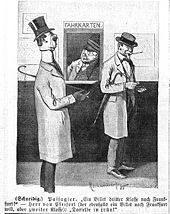The same in green
The same in green is a phrase that says that two things are almost the same or only differ in one feature. There is no definite explanation as to where the phrase comes from; there are several attempts at interpretation:
- According to one anecdote, a domestic worker gave a seller a pink ribbon as a sample with the words "Same color , but in green". This anecdote was mentioned as early as 1800 by Johanna Schopenhauer . In this context, she describes a stay with Johann Georg Zimmermann in Bad Pyrmont , during which her expectations were met, but in a completely different way than she had thought.
- At the 11th Annual Meeting of the General German Language Association held Hermann fertilizers (1843-1912) a lecture (reprinted 1899). In it, Dunger reports from his youth when people counted in French at billiards in his home country . He compares this with counting in English in tennis and adds as a summary: “'Same in green!' Back then the French idol was worshiped, now the English. "
- A drawing by Joseph Herrmannsdörfer (1867–1936) in Die Fliegende Blätter from 1903 shows a traveler at the ticket office who wants to purchase a ticket to the same destination as the passenger in front of him holding a third class ticket. With the words "Same in Jrün!" He indicates that he would like to purchase a ticket (marked in green) for the more expensive second class . Color-coded tickets were available from the Austrian State Railways shortly after the regulation of 1854, which provided for the 1st to 3rd class wagons to be painted in color. In 1874, the Prussian State Railroad followed suit with a decree that provided the same colors for cars and tickets as Austria: yellow for 1st class, green for 2nd class and brown for 3rd class.
- The Opel Laubfrosch , manufactured from 1924 onwards, was largely a copy of the Citroën 5CV , but was sold in the standard color green instead of yellow.
- A reference to the old German card game, in which “green” occurs as a color (comparable to spades), would also be conceivable .
Individual evidence
- ↑ a b c Duden: Idioms: Dictionary of German Idiomatics (= Der Duden in 12 volumes . Volume 11). Dudenverlag, ISBN 3-411-04112-9 , p. 299.
- ↑ a b Christiane Wanzeck: On the etymology of lexicalized color word combinations: Investigations using the colors red, yellow, green and blue , Rodopi, Amsterdam and New York 2003, ISBN 978-90-420-1317-9 , p. 130, preview in Google - Book search
- ↑ Johanna Schopenhauer: Jugendleben und Wanderbilder , Georg Westermann, Braunschweig 1839, p. 318
- ^ Against the English language in the German language. Lecture by Hermann Dunger, given at the 11th Annual General Meeting of the Allgemeine Deutsche Sprachverein, extended copy from the magazine of the Allgemeine Deutsche Sprachverein, 14th year No. 12, Berlin 1899, p. 11 ( DasSelbe in Grün… - Internet Archive ).
- ^ Alfons Thoma: The ticket. Symbol of overcoming space and boundaries . Hestra-Verlag, Darmstadt 1985, ISBN 3-7771-0185-0 , p. 22 .
